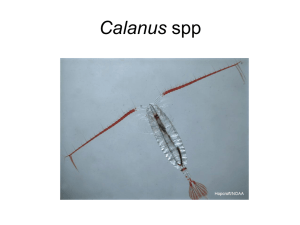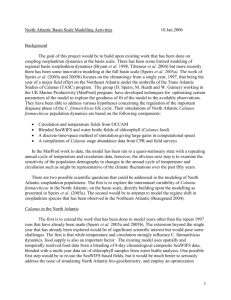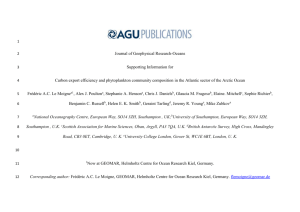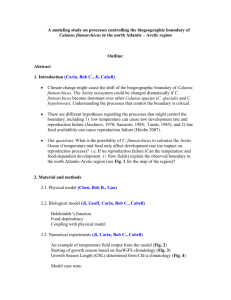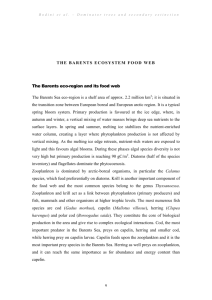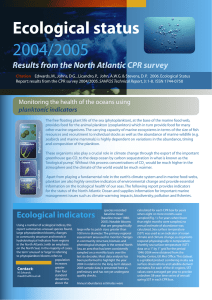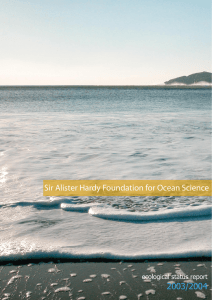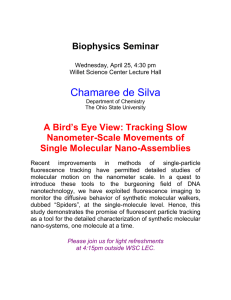S M Calanus genetic identification system*
advertisement
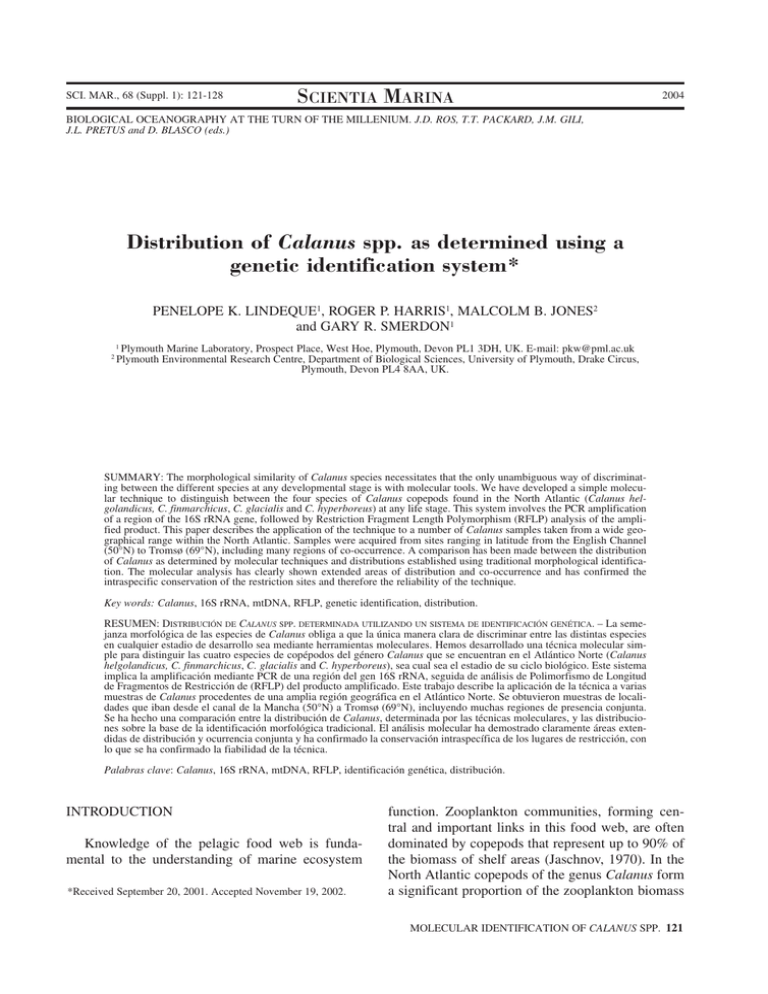
SCI. MAR., 68 (Suppl. 1): 121-128 SCIENTIA MARINA 2004 BIOLOGICAL OCEANOGRAPHY AT THE TURN OF THE MILLENIUM. J.D. ROS, T.T. PACKARD, J.M. GILI, J.L. PRETUS and D. BLASCO (eds.) Distribution of Calanus spp. as determined using a genetic identification system* PENELOPE K. LINDEQUE1, ROGER P. HARRIS1, MALCOLM B. JONES2 and GARY R. SMERDON1 1 2 Plymouth Marine Laboratory, Prospect Place, West Hoe, Plymouth, Devon PL1 3DH, UK. E-mail: pkw@pml.ac.uk Plymouth Environmental Research Centre, Department of Biological Sciences, University of Plymouth, Drake Circus, Plymouth, Devon PL4 8AA, UK. SUMMARY: The morphological similarity of Calanus species necessitates that the only unambiguous way of discriminating between the different species at any developmental stage is with molecular tools. We have developed a simple molecular technique to distinguish between the four species of Calanus copepods found in the North Atlantic (Calanus helgolandicus, C. finmarchicus, C. glacialis and C. hyperboreus) at any life stage. This system involves the PCR amplification of a region of the 16S rRNA gene, followed by Restriction Fragment Length Polymorphism (RFLP) analysis of the amplified product. This paper describes the application of the technique to a number of Calanus samples taken from a wide geographical range within the North Atlantic. Samples were acquired from sites ranging in latitude from the English Channel (50°N) to Tromsø (69°N), including many regions of co-occurrence. A comparison has been made between the distribution of Calanus as determined by molecular techniques and distributions established using traditional morphological identification. The molecular analysis has clearly shown extended areas of distribution and co-occurrence and has confirmed the intraspecific conservation of the restriction sites and therefore the reliability of the technique. Key words: Calanus, 16S rRNA, mtDNA, RFLP, genetic identification, distribution. RESUMEN: DISTRIBUCIÓN DE CALANUS SPP. DETERMINADA UTILIZANDO UN SISTEMA DE IDENTIFICACIÓN GENÉTICA. – La semejanza morfológica de las especies de Calanus obliga a que la única manera clara de discriminar entre las distintas especies en cualquier estadio de desarrollo sea mediante herramientas moleculares. Hemos desarrollado una técnica molecular simple para distinguir las cuatro especies de copépodos del género Calanus que se encuentran en el Atlántico Norte (Calanus helgolandicus, C. finmarchicus, C. glacialis and C. hyperboreus), sea cual sea el estadio de su ciclo biológico. Este sistema implica la amplificación mediante PCR de una región del gen 16S rRNA, seguida de análisis de Polimorfismo de Longitud de Fragmentos de Restricción de (RFLP) del producto amplificado. Este trabajo describe la aplicación de la técnica a varias muestras de Calanus procedentes de una amplia región geográfica en el Atlántico Norte. Se obtuvieron muestras de localidades que iban desde el canal de la Mancha (50°N) a Tromsø (69°N), incluyendo muchas regiones de presencia conjunta. Se ha hecho una comparación entre la distribución de Calanus, determinada por las técnicas moleculares, y las distribuciones sobre la base de la identificación morfológica tradicional. El análisis molecular ha demostrado claramente áreas extendidas de distribución y ocurrencia conjunta y ha confirmado la conservación intraspecífica de los lugares de restricción, con lo que se ha confirmado la fiabilidad de la técnica. Palabras clave: Calanus, 16S rRNA, mtDNA, RFLP, identificación genética, distribución. INTRODUCTION Knowledge of the pelagic food web is fundamental to the understanding of marine ecosystem *Received September 20, 2001. Accepted November 19, 2002. function. Zooplankton communities, forming central and important links in this food web, are often dominated by copepods that represent up to 90% of the biomass of shelf areas (Jaschnov, 1970). In the North Atlantic copepods of the genus Calanus form a significant proportion of the zooplankton biomass MOLECULAR IDENTIFICATION OF CALANUS SPP. 121 and play an important role as secondary producers in the marine food web, grazing extensively on phytoplankton and representing significant prey species for larvae, juveniles and adults of commercial fish (Dickson and Brander, 1993; Conover et al., 1995; Runge and Lafontaine, 1996). One of the persistent problems when investigating marine zooplankton communities, especially copepod communities, relates to the correct identification of the different species within a genus. The four major North Atlantic Calanus species have very similar morphologies, with diagnostic features being restricted to size or minor variations in secondary sex characteristics. This presents a persistent problem for the identification of individuals to species level, with immature animals being the most problematic. For the identification of such juvenile stages the geographic location of collection is, at least partially, relied upon as an indicator of species identity. It is important to distinguish between Calanus species because they have different vertical distributions and temperature affinities, yet they co-occur and compete interspecifically. For a better understanding of how each species differs in its life strategy and response to environmental conditions, we need to accurately describe their spatial and temporal pattern, and to do this we must have a reliable means of discriminating between the species. Despite morphological similarity, species of Calanus exhibit considerable base sequence divergence within their genomes (Bucklin et al., 1995). In the mitochondrial genome, the gene encoding the large subunit of ribosomal RNA (the 16S rRNA gene or 16S rDNA) has a sequence which varies sufficiently to discriminate closely-related species but that has an intraspecific variation which is generally low. Based on this gene a simple molecular technique to differentiate between the North Atlantic Calanus species (C. helgolandicus, C. finmarchicus, C. glacialis and C. hyperboreus) at any developmental stage has been developed (Lindeque et al., 1999). Using the polymerase chain-reaction (PCR), a region of the mitochondrial 16S rRNA gene can be amplified from individual copepods preserved in ethanol. Subsequent digestion of the amplified products with the restriction enzymes Dde I and Vsp I, followed by electrophoretic separation in 2% Metaphor agarose gel, produces a characteristic ‘fingerprint’ for each species. Using this system, it is possible to identify to species level not only whole animals 122 P.K. LINDEQUE et al. at any developmental stage from egg to adult, but also individual body parts. This paper describes the application of the diagnostic technique to a number of ethanol preserved animals taken from a wide geographical range within the North Atlantic, testing comprehensively the accuracy and reproducibility of the technique. The 16S rDNA primers (16SAR and 16SB2R) used for the amplification are complementary to conserved regions of the 16S gene, ensuring amplification from all four of the Calanus species studied. The restriction sites of the chosen enzymes Dde I and Vsp I are present at regions of variable sequence between the Calanus species under study and are therefore suitably diagnostic. From detailed comparisons of Calanus sequence data from geographically diverse conspecific populations these restriction sites show no intraspecific variation. However, a true test of the intraspecific conservation of the restriction sites, and therefore the method, is the application of the technique to Calanus samples collected from a wide geographical range. The need for an unambiguous method to discriminate between Calanus species was illustrated clearly in a study of Calanus populations in Lurefjorden (western coast of Norway). It is suspected that in Lurefjorden, the populations of Calanus are not composed of a single species; however, adult Calanus are of a similar size and therefore harder to separate into species than in other systems (Ketil Eiane, 1999 and pers. comm.). Calanus collected from the fjord were attributed to species level, using the morphological characteristics of the curvature of the coxa of the fifth pair of swimming legs. The identification was therefore restricted to CV stages and adult females. For a non-taxonomist this method is both time consuming and ambiguous, so it was decided to test the morphological identification of the Calanus species against molecular identification in a blind test of the samples. Finally, the distribution of Calanus in the North Atlantic determined by molecular techniques is compared with traditional distributions established using morphological discriminators. METHODS Collection and preservation of samples Individuals of Calanus spp. (adults and late copepodite stages) were collected from a wide range TABLE 1. – Location, method and depth of sample collections to which the molecular method of Calanus identification was applied. Samples collected by P. Lindeque1+6, S.R. Gonzalez and S.S. Oosterhuis2, E. Bagoien and K. Eiane3, E. Gaard4+5, X. Irigoien7, K. Olsen8, B. Hansen9+10. Location L4, English Channel 1 North Sea 2 Lurefjorden 3 Faroe shelf 4 Faroe off-shelf 5 Oban, West Scotland 6 Weathership M 7 Saltenfjord 8 Bergen 9 Tromsø 10 Method of collection Depth of collection Oblique tow Vertical haul Vertical haul Vertical haul Vertical haul Vertical haul Vertical haul Vertical haul Vertical haul Vertical haul 50-0 m 70-0 m 400-0 m 50-0 m 50-0 m 50-0 m 100-0 m 380-0 m 100-0 m 100-0 m of geographical locations in the North Atlantic with 200 µm WP-2 plankton nets. The source, location and method of collection of the Calanus samples are presented in Table 1. Samples collected from the English Channel, Lurefjorden, East Scotland, Weathership M, Saltenfjord, Bergen and Tromsø were stored in absolute ethanol with approximately 1 animal per 1 mL of ethanol. Samples collected from the North Sea were stored at a higher concentration (approximately 10-20 animals per 1 mL ethanol) and, for those samples collected around the Faroes, animals were stored at a significantly higher concentration (approximately 100 individuals per 1 mL of ethanol). Molecular identification of Calanus individuals The technique for molecular identification of Calanus individuals described by Lindeque et al. (1999) has been modified to reduce the cost of analysis. Modifications include the use of Taq DNA polymerase (Promega UK Ltd.) in preference to DynazymeTM (Flowgen Instruments Ltd.), and a reduction in the amount of restriction enzyme used for each reaction. The final technique is described below: Animals were rehydrated in 0.5 mL of MilliQ water in a microcentrifuge tube for 6-12 h at room temperature. After rehydration, the water was removed and replaced with 34 µL MilliQ water and 5 µL 10 x Taq DNA polymerase buffer (Promega UK Ltd.). Copepods were homogenised using a pellet pestle homogeniser (Anachem Ltd.) and incubated at 4°C overnight. After incubation, the homogenate was transferred to a 0.7 mL tube and the remaining reaction components were added [5 µL 2 mM dNTPs, 2.5 µL each of primers 16SAR and 16SB2R (100 ng µL-1), and 2 U of Taq DNA polymerase (Promega UK Ltd.)]. The amplification primers used were 16SAR (5’-CGCCTGTTTAACAAAAACAT-3’; Palumbi and Benzie 1991) and 16SB2R (5’-ATTCAACATCGAGGTCACAAAC-3’; custom designed from existing Calanus sequences). Amplification was performed in a thermal cycler (PTC-100, MJ Research, Inc). The cycling parameters included an initial denaturation step of 94oC (5 min) followed by 40 cycles of 45oC (2 min), 72oC (1 min), and 94oC (1 min). A final annealing phase at 45oC (2 min) was followed by an extension phase at 72oC (3 min) and storage at 4oC until use. Aliquots (10 µL) of the amplification reactions were analysed by agarose gel electrophoresis (1.5%) to check amplification efficiency. Restriction Fragment Length Polymorphism analysis Restriction digests were performed on a 15 µL aliquot from each amplification by the addition of 0.5 µL 5 M NaCl, 2 µL bovine serum albumin (1 mg mL-1) and 2.5 U of each restriction enzyme (Dde I and Vsp I). Incubations were performed at 37°C for 1 h. The digestion products were separated by electrophoresis through a 2% Metaphor agarose gel, prechilled for 30 min at 4°C to improve resolution. The gels were observed and photographed by UV transillumination. Comparison of morphological and molecular identification of Calanus species from Lurefjorden Using the morphological characteristics of the coxa on the fifth pair of swimming legs, Espen Bagoien (Norway) identified 154 Calanus collected from Lurefjorden. The ethanol-preserved animals were then individually subjected to molecular identification with no prior knowledge of the morphological results. Molecular identification of Calanus from a wide geographical range in the North Atlantic From Calanus samples obtained from each of the geographical areas shown in Table 1, between 20 and 30 individual animals were picked randomly from storage in ethanol. Each individual was identified using the technique described above. MOLECULAR IDENTIFICATION OF CALANUS SPP. 123 FIG. 1. – Species identification of Calanus from Lurefjorden. Comparison of morphological and molecular identification techniques. C. helg = Calanus helgolandicus, C. glac = C. glacialis, C. fin = C. finmarchicus, C. hyp = C. hyperboreous (n=153). RESULTS Preservation of samples Animals stored at concentrations of 1-20 individuals per 1 mL absolute ethanol were preserved successfully, and proved suitable for DNA amplification. Many samples of Calanus stored at a higher density (approximately 100 animals per 1 mL ethanol) appeared contaminated with copepod debris, possibly because of physical degradation during transportation. However, intact animals within these samples, following thorough washing in MilliQ water to remove any contaminating fragments, were still suitable for amplification. Molecular identification of Calanus individuals Over 99% of copepods analysed produced a PCR product of the correct size when amplified with the 16SAR and 16SB2R primers. Less than 1% of individual Calanus failed to produce any amplification product. All amplified products were digested successfully with Dde I and Vsp I to give a characteristic restriction profile for Calanus helgolandicus, C. finmarchicus, C. glacialis or C. hyperboreus. No aberrant restriction profiles were obtained. Comparison of morphological and molecular identification of Calanus species from Lurefjorden Calanus collected from Lurefjorden, following morphological identification in Norway, were char124 P.K. LINDEQUE et al. acterised to species level using the developed molecular technique. Out of 154 animals, 153 were identified successfully and 1 failed to produce an amplification product. The molecular results showed that 67% of the Calanus collected were C. glacialis, 32% were C. helgolandicus, and 1% were C. finmarchicus. No C. hyperboreous were found (Fig. 1). In comparison with determination of species by molecular techniques, 98% of Calanus were attributed to C. helgolandicus and/or C. glacialis species and 2% to C. finmarchicus species based on morphological identification (Fig. 1). Morphological identification was restricted to stage V copepodites and adult females. It appeared that the criteria used for the identification did not allow the separation of C. helgolandicus and C. glacialis species, and no convincing morphological trait was found to classify males to species level. The morphological methods of identification proved ambiguous and even after detailed examination of the morphological characteristics it was noted that many individuals were identified ‘with doubt’. A comparison between the molecular and morphological identification of Calanus highlights the limitations of morphological identification methods, and demonstrates clearly the potential of the molecular technique. The morphological identification was so limited that it precluded a direct comparison of species identification of individuals by morphological and molecular means. The results of the molecular technique showed that most Calanus were identified as either C. helgolandicus or C. glacialis, whereas by morphological means no such differentiation was possible between these two species. Molecular analysis also determined that 1% of the animals were C. finmarchicus, compared with 2% based on morphological identification. Only one Calanus individual was identified as C. finmarchicus by both morphological and molecular means. Distribution of Calanus species in the North Atlantic determined by the molecular technique Between 20 and 30 Calanus individuals (154 for Lurefjorden) were characterised to species level from each of 18 different geographical locations within the North Atlantic region (Fig. 2). Molecular identification showed that C. helgolandicus was distributed predominantly in the south of the area studied, being the sole representative of the genus in the English Channel sample. At eight of the locations sampled, C. helgolandicus cooccurred with C. finmarchicus, and at four of these locations, C. helgolandicus and C. finmarchicus cooccurred with C. glacialis. Calanus finmarchicus showed the greatest area of distribution, ranging from the North Sea (55°N), to Tromsø (69°N) and dominated the species composition in the Faroe Shetland channel and the North Atlantic basin (Fig. 2). At the most southerly edge of the range, C. finmarchicus cooccurred extensively with C. helgolandicus, and at the northern extreme with C. glacialis and/or C. hyperboreus. Although having a wide area of distribution (Oban, 56°N to Tromsø, 69°N), C. glacialis contributed only a small percentage of the Calanus species composition. The only location where C. glacialis dominated was in Lurefjorden (Norway). Calanus hyperboreus was found in the most northern FIG. 2. – Distribution of Calanus helgolandicus, C. finmarchicus, C. glacialis and C. hyperboreus, identified using 16S rDNA amplification and RFLP analysis. MOLECULAR IDENTIFICATION OF CALANUS SPP. 125 of the locations sampled, and co-occurred with C. helgolandicus, C. finmarchicus and C. glacialis. Only at one location did all four Calanus species occur together (Saltenfjord, 67°N; Fig. 2). DISCUSSION The simple molecular identification technique, involving amplification of 16S rDNA and subsequent RFLP analysis (modified from Lindeque et al., 1999), has been applied successfully to a number of samples of Calanus collected from a wide geographical area. The method was able to distinguish unambiguously between Calanus helgolandicus, C. finmarchicus, C. glacialis and C. hyperboreus with an amplification success rate of >99%. Animals stored in absolute ethanol, even at a high density of approximately 100 individuals per 1 mL of ethanol, were suitable for DNA amplification. This system of preservation is simple to use at sea, and appears suitable for transportation and longterm storage prior to molecular analysis. The success rate for amplification of the 16S rDNA fragment from preserved animals was over 99%. The small proportion of individuals, less than 1%, that failed to produce an amplification product, can probably be attributed to insufficient homogenisation of the animal. In all cases of successful amplification, the DNA product was digested successfully with Vsp I and Dde I to give a restriction profile characteristic of one of the four Calanus species. There were no aberrant restriction profiles from any geographical location. The application of the molecular technique has confirmed that the method can consistently discriminate unambiguously between the four Calanus species common to the North Atlantic. Over the geographical region studied the nucleotide sequences at the Dde I and Vsp I restriction sites are suitably conserved, proving that geographically distant conspecific populations do not affect the method. Hill et al. (2001) have also confirmed that sequence variation in Calanus mitochondrial DNA can be a diagnostic and accurate indicator of species identity. Using mitochondrial Cytochrome Oxidase I sequence variation a molecular technique for Calanus species identification, based on a multiplexed species specific PCR-protocol has been designed (Hill et al., 2001). Both protocols are suitable for the molecular diagnosis of Calanus species in the North Atlantic by untrained biologists and oceanographers. 126 P.K. LINDEQUE et al. An interesting result, revealed by the application of this molecular diagnostic technique, is the species composition of Calanus identified in Lurefjorden. Lurefjorden is virtually landlocked and has an invertebrate-dominated predator system. Compared to other fjords, Lurefjorden has a higher standing stock of Calanus that exhibit a high mortality rate early in life but a lower mortality rate in the early copepodite stages (Eiane et al., 1999). As with neighbouring fjords, it was thought that the Lurefjorden Calanus species composition predominantly included C. finmarchicus and C. helgolandicus. In contrast, the Lurefjorden species exhibited different egg production rates and predator/prey relationships (Eiane et al., 1999). The application of a molecular technique has revealed the presence of high numbers of C. glacialis in the fjord. Fortuitously the presence of three Calanus species in Lurefjorden has also been revealed by Bucklin et al., (2000) based on the DNA sequence of mt16S rDNA. The molecular-based systematic approach to Calanus has proved invaluable, exceeding the capabilities of traditional morphological taxonomy for the Calanus species in Lurefjorden. This molecular technique has alerted ecologists to the presence of three Calanus species in the fjord and has provided a tool for further research of this unusual ecosystem. Comparison of the morphological and molecular identification of Calanus species in Lurefjorden highlighted the weaknesses of traditional morphological methods. The morphological criteria used for identification were unable to discriminate between male Calanus, and did not allow separation of C. helgolandicus and C. glacialis. Although comparison between morphological and molecular characterisation techniques has obviously been limited, it is clear that a simple method of molecular identification is effectual, being more extensive and less ambiguous than morphological methods. Molecular identification of Calanus species from a wide geographical area within the North Atlantic has not only proved the accuracy and reproducibility of the technique, but has also stimulated some new interpretations of dispersal. The distribution of Calanus species determined by molecular analysis is mostly reflective of traditional results. However, the molecular analysis has clearly shown extended areas of distribution and cooccurrence. These results demonstrate the limitations of identification of Calanus species based solely on morphology and have highlighted the potential errors associated with relying on geo- graphical location for species determination. Calanus helgolandicus is a warm-temperate water species found in southern areas of the North Atlantic, the Celtic Sea, North Sea and in coastal waters south of England (Fleminger and Hulsemann, 1977; Planque and Fromentin, 1996). Recently the use of Generalized Additive Models in the analysis of Continuous Plankton Recorder (CPR) data have shown that C. helgolandicus are advected around the north of Scotland and into the North Sea through the Fair Isle Channel (Beare and McKenzie, 1999). These results indicate that the population of C. helgolandicus is increasing and colonising further north within the North Sea overtime. The occurrence of C. helgolandicus, determined by this molecular study, is generally supportive of the traditional distribution described above. It is however, surprising to find C. helgolandicus north of the Faroes, especially considering that the sample was collected in April when the water temperature was still low. Possibly, C. helgolandicus found in this area result from advective transport in the Atlantic stream. Calanus finmarchicus, a more cold-temperate water species than C. helgolandicus, is abundant in coastal and Atlantic water around Iceland (Gislasson and Astthorsson, 1995), and is found in the East Icelandic current water and the Arctic intermediate water around the Faroes. In this study, C. finmarchicus was observed as far south as 54oN in the North Sea and as far north as Grotsund, Tromsø. Traditionally, C. finmarchicus is thought to overlap extensively with C. helgolandicus in many areas of the North Atlantic and in the shelf seas around the United Kingdom (Williams and Conway, 1980). The two Calanus species co-occur extensively in surface waters of the Northeast Atlantic during spring and in the surface waters of the North Sea during summer and autumn (Planque and Fromentin, 1996). The molecular analysis of samples clearly reflects this distribution, with a co-occurrence of C. finmarchicus and C. helgolandicus seen in the Faroe and west of Scotland samples collected in April and May, and in the North sea sample obtained in July. Planque and Fromentin (1996), from an analysis of CV and CVI animals collected in the subsurface layer, estimated that the region of co-occurrence of C. finmarchicus and C. helgolandicus extended from 52oN to 57oN in the North Sea and Northeast Atlantic. It is obvious from this molecular study that the sympatric area of these two species extends well above 57oN. Calanus glacialis, predominantly an Arctic water species (Frost, 1974), has a reproductive range overlapping with both C. helgolandicus and C. finmarchicus (Fleminger and Hulsemann, 1977). From molecular analysis there are four regions where these three species of Calanus co-occur: north of the Faroe isles; Saltenfjord and Lurefjorden, western Norway; and Oban, western Scotland. It was perhaps not anticipated to observe C. glacialis as far south as Oban compared to traditional, morphologically determined distributions. Calanus hyperboreus is a northern Arctic cold water species that has a population centred in the Greenland Sea (Conover, 1988; Hirche, 1991). Calanus hyperboreus shows overlapping distributions with C. finmarchicus and C. glacialis at the front between the Atlantic and Arctic water masses in the Northeast Atlantic (Hirche et al., 1994). Molecular identification of Calanus has shown three sympatric areas of C. hyperboreus, C. glacialis and C. finmarchicus. This molecular study has demonstrated a greater co-occurrence of Calanus species than traditionally thought. The extent of the sympatric areas may not have been previously realised, because geographical location has played a significant role in species determination, with obvious consequences. Taking into account the difficulties associated with morphologically distinguishing between Calanus species, especially considering the extent of overlap in the length distributions of C. finmarchicus and C. glacialis (Jaschnov, 1972; Frost, 1974), it is probable that Calanus species have been misidentified previously, affecting knowledge of geographical distributions. Traditionally, Calanus distributions have been based on CV and adults, because of the difficulties in identifying earlier stages. Williams and Conway (1980) gave evidence that the vertical temperature gradient was responsible for differences in the vertical distributions of co-occurring C. finmarchicus and C. helgolandicus, and between different stages within a species. However, because of the difficulty in identifying early developmental stages, assumptions on the vertical distribution of different stages from a site of sympatric distribution had to be drawn from analysis of isolated species. The molecular tool, allowing the unambiguous identification of Calanus species at any developmental stage, has obvious implications in describing the distributions of Calanus juveniles. In areas of extreme distribution, or unexpected co-occurrence, it is not known whether adult populations are coinMOLECULAR IDENTIFICATION OF CALANUS SPP. 127 cident with younger populations. Such a question is of ecological importance because the presence of young stages would be indicative of a growing population. If no eggs or nauplii were present, it may be assumed that the older stages have been transported to their site of collection. Answering such questions is only possible with the developed molecular technique. The four Calanus species, for which this molecular identification technique has been designed, are the predominant species in the North Atlantic. However, Calanus marshallae has been identified recently in Arctic waters in Isfjorden, Spitsbergen (Sundt and Melle, 1998) by sequence data analysis of an amplified region of 16S rDNA. This appears to be an isolated case and, therefore, does not warrant extension of the developed technique to include such species. However, were future samples to produce aberrant restriction profiles, sequence data would be obtained for the 16S amplification product to obtain species identity, and the profile noted and used in future diagnosis. The relatively simple and inexpensive molecular method, developed for the identification of the North Atlantic Calanus species, is reliable and reproducible. The technique has shown a huge potential for better describing and understanding the distribution of this important copepod genus. Correct species identification is the keystone of ecological studies, and accurate descriptions of the spatial and temporal patterns of Calanus species are invaluable for understanding and predicting the response of the different species to environmental conditions. ACKNOWLEDGEMENTS This work was funded by the NERC special topic PRIME (Plankton Reactivity in the Marine Environment) and was partially supported by funding from the European Commission through the TASC project (MAS3-CT95_0039). We are grateful to E. Bagoien, K. Eiane, E. Gaard, S. R. Gonzalez, B. Hansen, X. Irigoien, K. Olsen, and S. S. Oosterhuis for supplying samples of Calanus species. We would also like to thank Joanne Shepherd for all her help with the molecular identification of Calanus species during a work-experience placement. 128 P.K. LINDEQUE et al. REFERENCES Beare, D. and E. McKenzie. – 1999. The multinominal logit model: a new tool for exploring Continuous Plankton Recorder data. Fish. Oceanogr., 8(Suppl. 1): 25-39. Bucklin, A, S. Kaartvedt, M. Guarnieri and U. Goswami. – 2000. Population genetics of drifting (Calanus spp.) and resident (Acartia clausi) plankton in Norwegian fjords. J. Plank. Res., 22: 1237-1251. Bucklin, A., B.W. Frost and T.D. Kocher. – 1995. Molecular systematics of six Calanus and three Metridia species (Calanoida; Copepoda). Mar. Biol., 121: 655-664. Conover, R.J. – 1988. Comparative life histories in the genera Calanus and Neocalanus in high latitudes of the northern hemisphere. Hydrobiologia, 167/168: 127-142. Conover, R.J., S. Wilson, G.C.H., Harding and W.P. Vass. – 1995. Climate, copepods and cod: some thoughts on the long-range prospects for a sustainable northern cod fishery. Climate Research, 5: 69-82. Dickson, R.R. and K.M. Brander. – 1993. Effects of a changing windfield on cod stocks of the North Atlantic. Fish. Oceanogr., 2: 124-153. Eiane, K., D.L. Aksnes, M.D. Ohman, S. Wood and M.B. Martinussen. – 1999. Stage specific mortality of Calanus spp. under different predator regimes. Abstract, ICES symposium Population dynamics of Calanus in the North Atlantic - results from the trans Atlantic study of Calanus finmarchicus. Fleminger, A. and K. Hulsemann. – 1977. Geographical range and taxonomic divergence in North Atlantic Calanus (C. helgolandicus, C. finmarchicus, and C. glacialis). Mar. Biol., 40: 233-248. Frost, B.W. – 1974. Calanus marshallae, a new species of Calanoid copepod closely related to the sibling species C. finmarchicus and C. glacialis. Mar. Biol., 26: 77-99. Gislasson, A. and O.S. Astthorsson. – 1995. Seasonal cycle of zooplankton southwest of Iceland. J. Plankton Res., 17: 1959-1976. Hirche, H.J. – 1991. Distribution of dominant copepod species in the Greenland Sea during fall. Polar Biol., 11: 351-362. Hirche, H.J., W. Hagen, N. Mumm and C. Richter. – 1994. Mesozooplankton and macrozooplankton distribution and production of dominant herbivorous copepods during spring. Polar Biol., 14: 491-503. Hill, R.S., L.D. Allen and A. Bucklin. – 2001. Multiplexed speciesspecific PCR protocol to discriminate four N. Atlantic Calanus species, with a mtCOI gene tree for ten Calanus species. Mar. Biol., 139: 279-287. Jaschnov, V.A. – 1970. Distribution of Calanus species in the seas of the Northern Hemisphere. Internat. Rev. ges. Hydrobiol., 55: 197-212. Jaschnov, V.A. – 1972. On the systematic status of C. glacialis, C. finmarchicus, and C. helgolandicus. Crustaceana, 22: 279-284. Lindeque, P.K., R.P. Harris, M.B. Jones and G.R. Smerdon. – 1999. Simple molecular method to distinguish the identity of Calanus species (Copepoda: Calanoida) at any developmental stage. Mar. Biol., 133: 91-96. Planque, B. and J.-M. Fromentin. – 1996. Calanus and environment in the eastern North Atlantic. I. Spatial and temporal patterns of C. finmarchicus and C. helgolandicus. Mar. Ecol. Prog. Ser., 134: 101-109. Runge, J.A. and Y.D. Lafontaine. – 1996. Characterisation of the pelagic ecosystem in surface waters of the northern Gulf of St. Lawrence in early summer: the larval redfish – Calanus – microplankton interaction. Fish. Oceanogr., 5: 1-20. Runge, J.A. and J.C. Roff. – 1999. The measurement of growth and reproductive rates. In: R. Harris, P.H. Wiebe, J. Lenz, H.-R. Skjoldal and M. Huntley (eds.), ICES Zooplankton Methodology Manual, pp. 401-532. Academic Press. Sundt, T.M. and W. Melle. – 1998. Atlantic observations of Calanus marshallae (Copepoda: Calanoida). Mar. Ecol. Prog. Ser., 166: 207-210. Williams, R. and D.V.P. Conway. – 1980. Vertical distribution of Calanus finmarchicus and C. helgolandicus (Crustacea: Copepoda). Mar. Biol., 69: 57-61.
